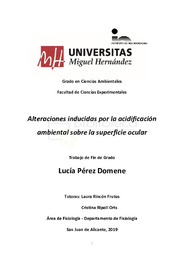Please use this identifier to cite or link to this item:
https://hdl.handle.net/11000/26976Full metadata record
| DC Field | Value | Language |
|---|---|---|
| dc.contributor.advisor | Rincón Frutos, Laura | - |
| dc.contributor.advisor | Ripoll Orts, Cristina | - |
| dc.contributor.author | Pérez Domene, Lucía | - |
| dc.contributor.other | Departamentos de la UMH::Fisiología | es_ES |
| dc.date.accessioned | 2022-05-10T07:27:48Z | - |
| dc.date.available | 2022-05-10T07:27:48Z | - |
| dc.date.created | 2019-07-11 | - |
| dc.identifier.uri | http://hdl.handle.net/11000/26976 | - |
| dc.description.abstract | El aumento de sustancias acidificantes en la atmósfera en las últimas décadas, como el dióxido de azufre (SO2), los óxidos de nitrógeno (NO, NO2) o el dióxido de carbono (CO2), principales responsables de la contaminación, han generado la necesidad de conocer sus efectos en el medio ambiente y en la salud de los seres vivos. Respecto a los efectos sobre la salud, la mayoría de los estudios se han centrado sobre todo en la exposición y sus consecuencias sobre el sistema respiratorio y el sistema cardiovascular. Menos estudiados han sido los efectos producidos sobre la superficie ocular, un sistema altamente expuesto al ambiente. La superficie ocular es de fácil acceso y puede ser examinada empleando métodos sencillos y poco invasivos. Por tanto, puede ser utilizada como un indicador del impacto de la polución sobre la salud. En este trabajo se estudia la influencia del pH ácido ambiental en la actividad basal y en la respuesta a distintos estímulos de las neuronas sensoriales primarias del ojo, así como su posible papel en la aparición de cambios en el funcionamiento fisiológico del párpado, como la tasa de parpadeo y lagrimación. | es_ES |
| dc.description.abstract | The increase of acidifying substances in the atmosphere in the last decades, such as sulfur dioxide (SO2), nitrogen oxides (NO, NO2) or carbon dioxide (CO2), which represent the main factors responsible for pollution, have generated the need to know its effects on the environment and on the health of living beings. Regarding health effects, most studies have focused mainly on the exposure of the respiratory and cardiovascular systems. Less attention has been paid to the effects on the ocular surface, a system highly exposed to the environment. 4 The ocular surface is easily accessible and can be examined using simple and non-invasive methods. Therefore, it can be used as an indicator of the impact of pollution on health. In this work we study the influence of acid environmental pH on the basal activity and the response to stimuli of the primary sensory neurons of the eye, as well as its possible role in alterations in the physiological functioning of eyelids, such as blinking and tearing rate. | es_ES |
| dc.format | application/pdf | es_ES |
| dc.format.extent | 38 | es_ES |
| dc.language.iso | spa | es_ES |
| dc.publisher | Universidad Miguel de Hernández de Elche | es_ES |
| dc.rights | info:eu-repo/semantics/openAccess | es_ES |
| dc.rights | Attribution-NonCommercial-NoDerivatives 4.0 Internacional | * |
| dc.rights.uri | http://creativecommons.org/licenses/by-nc-nd/4.0/ | * |
| dc.subject | córnea | es_ES |
| dc.subject | termorreceptores de frío | es_ES |
| dc.subject | nociceptores polimodales | es_ES |
| dc.subject | pH ácido | es_ES |
| dc.subject | sustancias acidificantes | es_ES |
| dc.subject | contaminación atmosférica | es_ES |
| dc.subject.other | CDU::5 - Ciencias puras y naturales::50 - Generalidades sobre las ciencias puras::504 - Ciencias del medio ambiente | es_ES |
| dc.title | Alteraciones inducidas por la acidificación ambiental sobre la superficie ocular | es_ES |
| dc.type | info:eu-repo/semantics/bachelorThesis | es_ES |

View/Open:
TFG-LUCÍA PÉREZ DOMENE.pdf
2,31 MB
Adobe PDF
Share:
.png)
